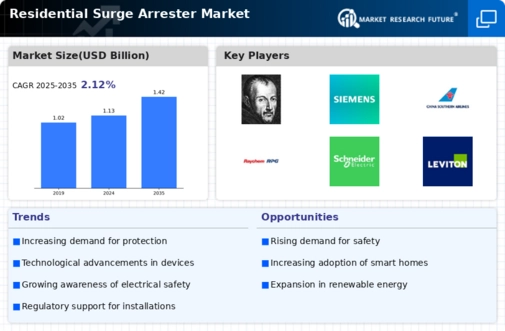Market Growth Projections
The Global Residential Surge Arrester Market Industry is projected to experience steady growth, with an estimated market value of 1.13 USD Billion in 2024 and a forecasted increase to 1.42 USD Billion by 2035. This growth trajectory suggests a compound annual growth rate of 2.09% from 2025 to 2035, indicating a sustained demand for surge protection solutions. Factors such as increasing consumer awareness, technological advancements, and regulatory compliance are likely to contribute to this positive outlook. As the market evolves, it may witness further innovations and adaptations to meet the changing needs of consumers.
Regulatory Compliance and Standards
The establishment of stringent regulatory frameworks and safety standards is a crucial driver for the Global Residential Surge Arrester Market Industry. Governments worldwide are implementing regulations that mandate the use of surge protection devices in residential buildings, particularly in regions prone to electrical disturbances. Compliance with these regulations not only enhances safety but also encourages manufacturers to innovate and improve their product offerings. This regulatory push is likely to contribute to a compound annual growth rate of 2.09% from 2025 to 2035, as more households adopt surge arresters to meet compliance requirements and protect their electrical systems.
Increasing Demand for Electrical Safety
The growing awareness regarding electrical safety among consumers is a pivotal driver for the Global Residential Surge Arrester Market Industry. As households increasingly rely on electronic devices, the risk of voltage surges has escalated, prompting homeowners to invest in surge protection solutions. This trend is reflected in the projected market value of 1.13 USD Billion in 2024, indicating a robust demand for residential surge arresters. Governments and safety organizations are also advocating for enhanced electrical safety standards, further propelling the adoption of surge arresters in residential settings. Consequently, this heightened focus on safety is likely to sustain market growth in the coming years.
Rising Incidence of Power Quality Issues
The increasing frequency of power quality issues, such as voltage fluctuations and transients, is driving the demand for surge protection solutions in the Global Residential Surge Arrester Market Industry. As urbanization and industrial activities expand, the electrical grid faces greater stress, leading to more frequent surges. Homeowners are becoming more aware of the potential damage these surges can cause to their electronic devices, prompting them to invest in surge arresters. This trend is expected to bolster market growth, as consumers seek reliable solutions to safeguard their investments in electronics and appliances.
Growth of Smart Homes and IoT Integration
The proliferation of smart home technologies is emerging as a significant driver for the Global Residential Surge Arrester Market Industry. As more households adopt smart devices, the need for reliable surge protection becomes increasingly critical. Smart homes often contain interconnected devices that can be vulnerable to power surges, leading to potential damage and safety hazards. Surge arresters designed for smart homes not only protect devices but also enhance overall system reliability. This growing trend is anticipated to contribute to the market's expansion, as consumers prioritize the protection of their smart investments.
Technological Advancements in Surge Protection
Technological innovations in surge protection devices are significantly influencing the Global Residential Surge Arrester Market Industry. The introduction of smart surge arresters equipped with advanced features, such as remote monitoring and real-time alerts, enhances user experience and safety. These innovations not only improve the efficiency of surge protection but also cater to the evolving needs of tech-savvy consumers. As a result, the market is expected to witness a steady growth trajectory, with a projected value of 1.42 USD Billion by 2035. The integration of IoT technology into surge protection devices may further drive consumer interest, indicating a potential shift in market dynamics.




















Leave a Comment